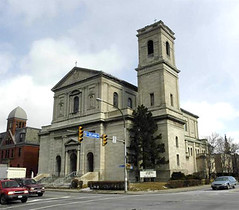Paradise in a parking lot: is history still history if it is relocated?

Posted February 17, 2010 at 1:35PM
Is a historic city church still historic if it is no longer on its site, or even in a city? The question is posed directly in the case of the spectacular old St. Gerard’s Roman Catholic basilica in Buffalo, which is now likely to be moved to an Atlanta suburb. It’s hard to fathom a more telling and troubling symbol of the growth of the new, Sun Belt America at the expense of the old, industrial America.
But, as Scott Doyon writes on the PlaceShakers and Newsmakers blog, it’s not a total loss, is it?  A wonderful building is, in fact, being preserved, when it would likely be lost in its original location. Scott believes it is even a “sign of hope” for remaking the suburbs:
A wonderful building is, in fact, being preserved, when it would likely be lost in its original location. Scott believes it is even a “sign of hope” for remaking the suburbs:
“Mary Our Queen Catholic Church, a growing, 15 year old suburban congregation in Norcross, Georgia, is looking for a permanent home. But rather than build something new, they’re looking to purchase a spectacular, historic Buffalo, New York, basilica and move it nearly a thousand miles south, piece by piece, to be reassembled.
“The church calls it “preservation through relocation” and claims new construction of equal quality would cost more than twice as much. The whole project seems like a solid exercise in pragmatic preservation . . .”
(Scott co-authors PlaceShakers with his colleague Ben Brown in the town planning firm PlaceMakers.)
But I wonder. One of my heroes and professional friends in smart growth has been Dick Moe, longtime president of the National Trust. I think Dick’s most powerful contribution to his (and our) cause was to embed the truth that history and preservation are as much about community and neighborhood as about buildings. He was, and is, so right about that.
I remember in the late 1970s reading an article in Harper’s about my home town, Asheville, North Carolina. It was titled “Goodbye, Asheville” and described how much of the neighborhood around favorite son and novelist Thomas Wolfe’s historic home had been razed for schlock buildings that some people once thought were a good idea. I was a part-time working musician then, and the subject became the inspiration for one of my audience’s favorite songs, “You Can’t Go Home Again.”  I knew absolutely nothing about cities or the environment in a professional sense at the time, but the topic registered in a personal way. Context matters. (Although the Wolfe home no longer has its neighborhood, on the whole Asheville’s context survived the 1970s and ‘80s better than most.)
I knew absolutely nothing about cities or the environment in a professional sense at the time, but the topic registered in a personal way. Context matters. (Although the Wolfe home no longer has its neighborhood, on the whole Asheville’s context survived the 1970s and ‘80s better than most.)
Scott seems more hopeful than not in his blog post but, as he acknowledges, “there’s a devil in the details” regarding the relocation of St. Gerard’s: while its old site was rooted in its neighborhood setting, the new one will isolate it, at best as a monumental temple on a hill. It will be within walking distance of nothing. Moreover, as “original green” architect Steve Mouzon notes in the comments, it will also most likely be surrounded by a parking lot. Is this progress? Is it preservation? As Scott wrote on Facebook when he shared the link to his very provocative post, it’s the kind of thing that makes you go “hymn.”